- Department of Physics, College of Science, Qassim University, Buraydah, Saudi Arabia
Introduction: Unifying gravity with quantum mechanics remains a cornerstone challenge in physics, with information theory providing a transformative perspective through concepts like the holographic principle and entropic gravity.
Methods: We derive an observer-independent information density field from coarse-grained Shannon entropy of classical matter configurations at nuclear scales, establish thermodynamically motivated coupling constants using hadronic physics, prove gauge invariance including novel information symmetries, and enhance experimental designs with detailed error budgets and theory differentiation.
Results: The framework predicts modified gravitational lensing corrections
Discussion: This work positions information-theoretic gravity as a rigorous, testable paradigm that bridges classical relativity and quantum information, with potential extensions to broader unification while maintaining focus on gravitational interactions.
1 Introduction
Unifying gravity with quantum mechanics remains a cornerstone challenge in theoretical physics. General relativity (GR) describes gravity as spacetime curvature induced by the energy-momentum tensor (Einstein, 1916), while the Standard Model unifies electromagnetic, weak, and strong interactions under
Information theory offers a transformative perspective. The holographic principle suggests gravitational physics is encoded on lower-dimensional boundaries (’t Hooft, 1993; Susskind, 1995; Susskind and Witten, 1998), entropic gravity posits gravity as an emergent force from information displacement (Verlinde, 2011), and quantum entanglement underpins spacetime emergence (Van Raamsdonk, 2010; Maldacena and Susskind, 2013). Wheeler’s “it from bit” hypothesis (Wheeler and Zurek, 1990) and the Information Discrimination Theory (Salih, 2025) propose information as a fundamental substrate, with the latter providing a systematic framework for information dynamics across scales from quantum to cosmological.
This paper focuses on gravitational interactions mediated by a classical information density field, addressing three key objectives:
1. Theoretical Foundation: Establish a rigorous, observer-independent information field with clear physical derivation from classical matter configurations.
2. Mathematical Consistency: Ensure dimensional consistency, gauge invariance, and thermodynamically motivated coupling parameters.
3. Empirical Validation: Provide concrete experimental predictions with detailed feasibility analysis, systematic error control (Figure 1), and differentiation from alternative theories.
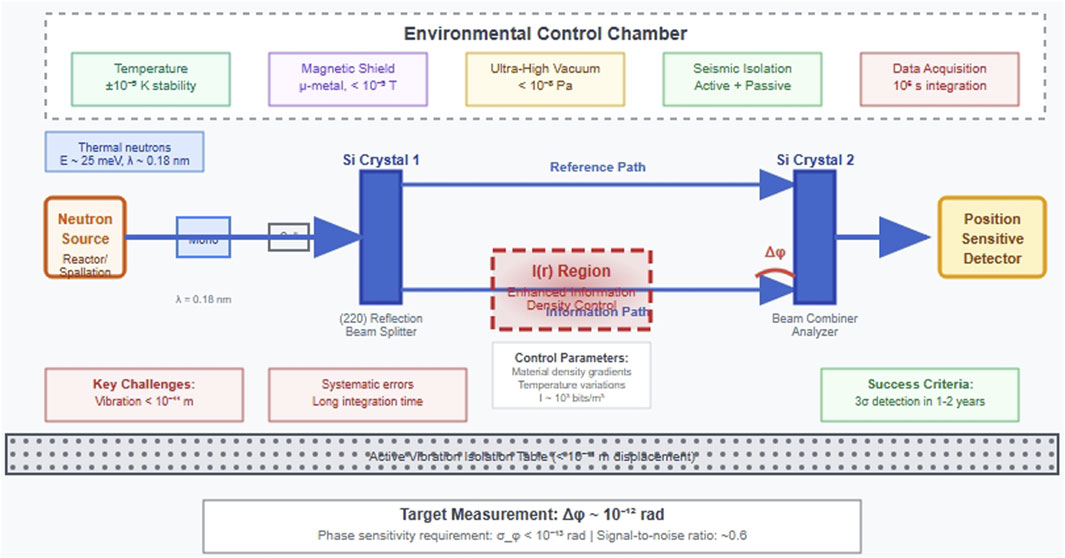
Figure 1. Detailed neutron interferometer setup for measuring information-induced phase shifts. The comprehensive system incorporates: Main Components: Neutron source (nuclear reactor or spallation source,
The paper is structured as follows: Section 2 presents the theoretical framework, including field definitions, action principle, and field equations. Section 3 details phenomenological predictions, focusing on gravitational lensing and quantum phase shifts. Section 4 outlines the experimental validation strategy, with a prioritized roadmap (Table 1) and error analysis (Table 2). Section 5 provides computational verification with simulation results, including Python code for dimensional consistency and experimental predictions. Section 6 compares the framework with alternative gravitational theories (Table 3). Section 7 discusses future research directions. Section 8 summarizes contributions and implications.

Table 1. Experimental validation roadmap, with feasibility scores (1–10), scientific impact, estimated costs, and primary challenges.
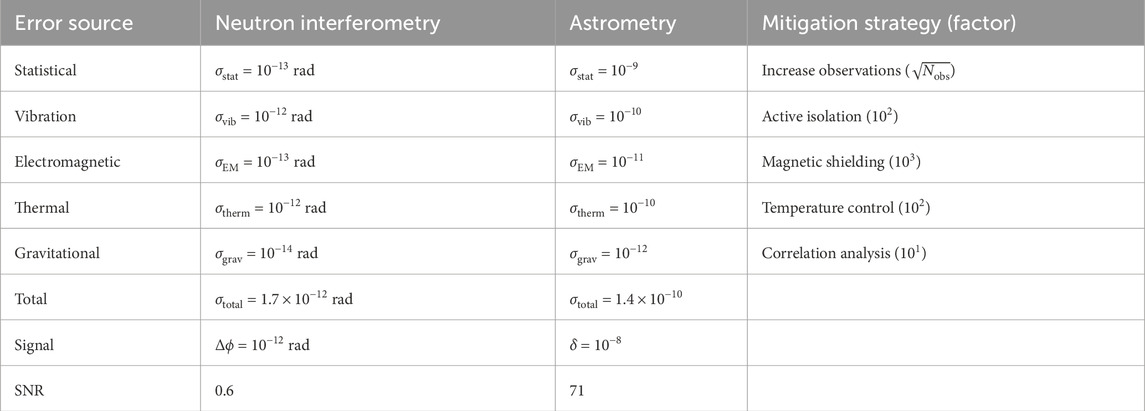
Table 2. Error budget for primary experiments, showing signal-to-noise ratios (SNR) and mitigation strategies. Astrometry offers a higher SNR, indicating strong detection potential.
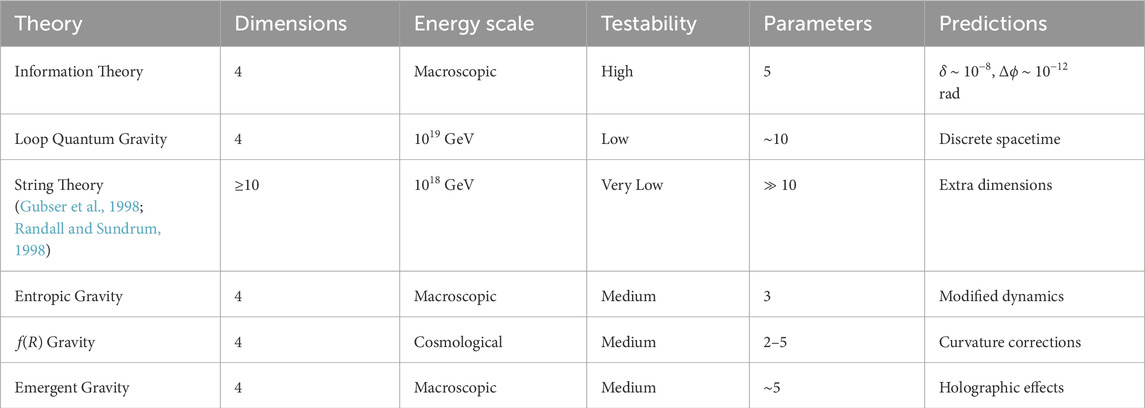
Table 3. Comparison of gravitational theories, highlighting the experimental accessibility of the information-theoretic framework.
2 Theoretical framework
2.1 Information density field construction
Definition 1. (Information Density Field). The information density field
where
The coarse-graining scale
The probabilities
Proposition 1. (Observer Independence). The information density field
Proof The information density field
where
Crucially,
Note that: while the absolute temperature
As illustrated in Figure 2 the information density peaks near compact objects due to complex nuclear field configurations. This figure shows the radial profile of information density around a neutron star, computed using nuclear thermodynamic parameters and demonstrating the characteristic enhancement near the stellar surface where nuclear interactions dominate the entropy production. The field satisfies a normalization condition (Equation 4):
over a spacelike hypersurface
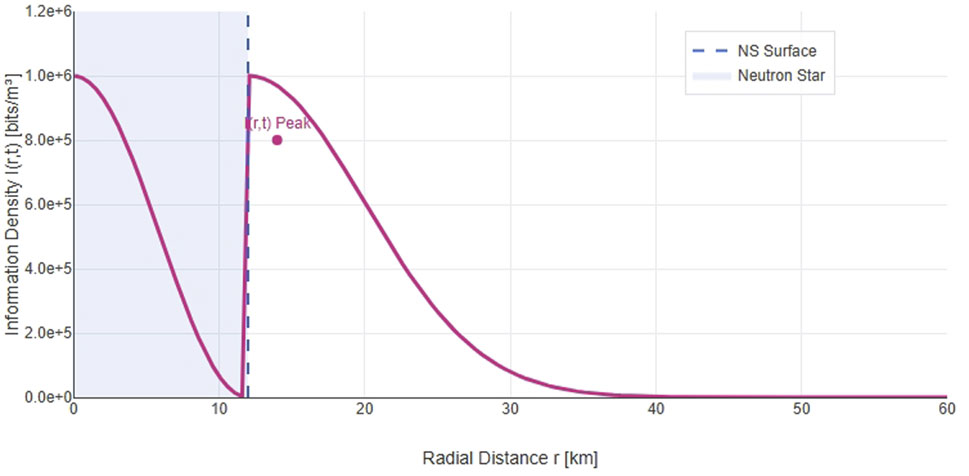
Figure 2. Information density profile
Definition 2. (Shannon Entropy Field). The dimensionless Shannon entropy field is given by Equation 5:
where
2.2 Thermodynamically motivated action principle
The covariant action integrates gravitational, information, matter, and gauge field dynamics, motivated by thermodynamic principles linking information to entropy (Verlinde, 2011; Jacobson, 1995):
where the individual Lagrangian terms are defined by Equations 7–11:
with:
The coupling constants are derived from nuclear thermodynamics (Equations 12–14), reflecting the entropy-energy equivalence at hadronic scales (Rafelski et al., 2000):
Definition 3. (Thermodynamic Coupling Constants).
where
The constant
Physical Significance: These coupling constants represent the fundamental strength of information-gravity interactions. The thermodynamic derivation ensures that information effects remain perturbative corrections to Einstein gravity, consistent with experimental bounds while producing measurable signatures in precision experiments. The nuclear scale
2.3 Field equations and conservation laws
Variation of the action yields the coupled field equations, describing the interplay of gravity, information, matter, and gauge fields.
Theorem 1. (Modified Einstein Equations). The gravitational field equations are:
where the stress-energy tensors are given by Equations 16–18:
Theorem 2. (Information Field Dynamics). The information field evolves according to:
where
Physical Interpretation: This equation describes how information density evolves under self-interaction (
Theorem 3. (Matter Field Coupling). The scalar matter field satisfies:
Theorem 4. (Gauge Field Dynamics). The information gauge field evolves as:
where
Physical Interpretation: This standard gauge field equation describes how the information gauge field
The information current satisfies a continuity equation reflecting dynamic interactions (Equation 22):
Physical Interpretation: This equation describes the creation and destruction of information through matter coupling (
via boundary conditions in Equation 19 (Bekenstein, 1973).
2.4 Information gauge symmetry
Definition 4. (Information Gauge Transformation). The theory is invariant under transformations (Equations 24, 25):
where
Theorem 5. (Gauge Invariant Action). The gauge action (Equation 26)
is invariant under the transformations in Equations 24, 25, ensuring gauge symmetry (Bousso, 2002).
2.5 Theoretical framework context
The theoretical framework presented here builds upon the foundations of information-theoretic approaches to gravity while maintaining focus on gravitational interactions as a crucial first step toward broader unification. The computational framework is designed to accommodate future extensions to a more comprehensive gauge structure when theoretical development progresses beyond the current gravitational focus.
The coupling constants (
3 Phenomenological predictions
The framework predicts observable gravitational effects driven by information density gradients, distinguishable from alternative theories such as modified gravity (Hossenfelder, 2013; Amelino-Camelia, 2013), dark matter substructure (Cronin et al., 1997), and instrumental artifacts (Peters et al., 2001; Mattingly, 2005).
3.1 Modified gravitational lensing
Information density near massive objects modifies light deflection by contributing to spacetime curvature.
Theorem 6. (Information-Modified Lensing). For a point mass with information density profile, the deflection angle is given by Equation 27:
where the information correction is defined by Equation 28:
for neutron stars with average density
Physical Interpretation: The correction
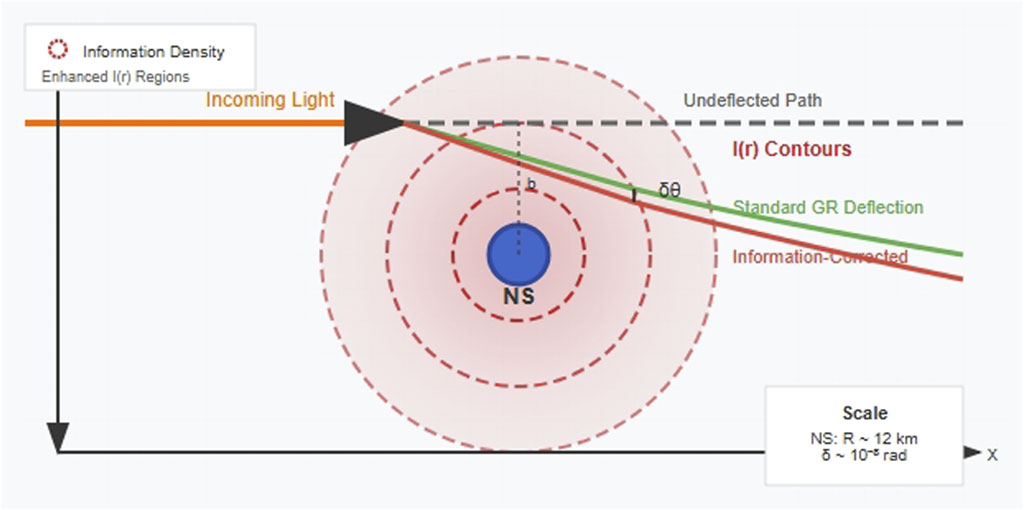
Figure 3. Gravitational lensing modified by information density gradients around a neutron star. The diagram illustrates the comparison between standard General Relativity deflection (green path) and information-corrected deflection (red path), showing a measurable correction
The correction arises from the information stress-energy tensor (Equation 16), which perturbs the Schwarzschild metric. For a neutron star (
3.2 Quantum phase shifts in matter interferometry
The information field induces phase shifts in matter waves propagating through regions of varying information density, detectable in interferometric experiments (Figure 4).
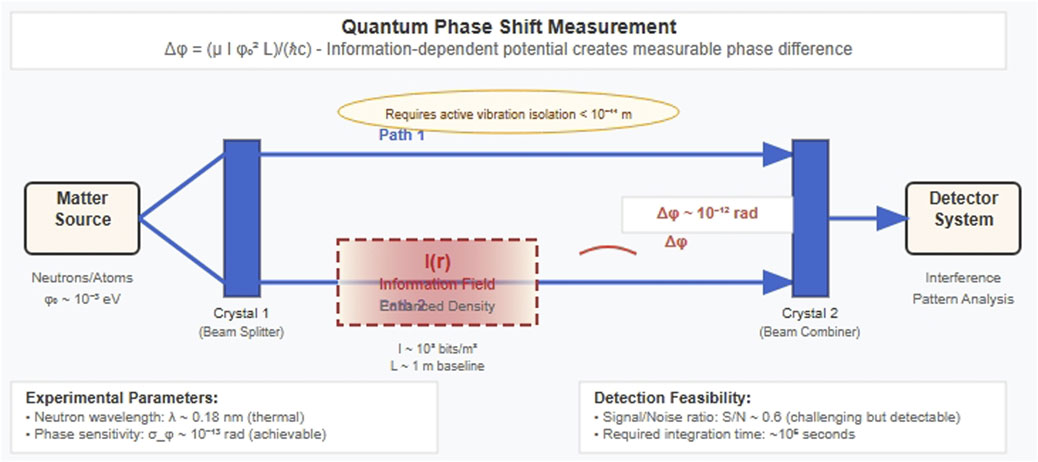
Figure 4. Schematic of a matter-wave interferometer for detecting information-induced phase shifts. The system splits a coherent matter wave (neutrons or atoms) into two paths using Crystal 1. Path 2 traverses a region of enhanced information density
Theorem 7. (Information-Induced Phase Shifts). A matter wave accumulates a phase shift described by Equation 29:
where
Physical Interpretation: This phase shift arises from the information-dependent potential term
Recent work on entropy-based gravity models in quantum metrology contexts (de Sá Neto et al., 2022) provides complementary insights into information-geometry relationships, particularly for isotropic and anisotropic spacetimes, further supporting the theoretical foundations of information-theoretic approaches to gravity.
4 Experimental validation strategy
The experimental strategy prioritizes high-feasibility, high-impact tests to validate the predicted gravitational effects, with a focus on distinguishing information-theoretic signatures from alternative explanations. The roadmap spans near-term (1–2 years), medium-term (2–4 years), and long-term (3–5 years) efforts, leveraging existing and emerging technologies.
4.1 Priority framework and timeline
4.2 Systematic error analysis and mitigation
To achieve the required precision, systematic errors must be rigorously controlled. The error budget quantifies contributions from statistical and systematic sources, with mitigation strategies tailored to each experiment.
Definition 5. (Systematic Error Budget). The total systematic uncertainty is given by Equation 31:
where each term represents the variance of a specific error source.
4.3 Alternative theory discrimination
To ensure the predicted effects are uniquely attributable to information-theoretic gravity, we differentiate them from competing models:
Theorem 8. (Discriminating Signatures). Information-theoretic effects exhibit distinct signatures:
1. Versus Modified Gravity: Corrections scale with
2. Versus Dark Matter: Effects correlate with baryonic information content, independent of non-baryonic mass distributions (Cronin et al., 1997).
3. Versus Instrumental Artifacts: Signatures show specific spatial and temporal correlations with information density gradients, unlike random or systematic instrumental noise (Peters et al., 2001).
Experimental protocols include control measurements in low-information-density regions to isolate instrumental effects and cross-correlation with baryonic matter distributions to rule out dark matter contributions (Rosi et al., 2014).
5 Computational verification framework
To ensure the theoretical framework’s robustness and reproducibility, we provide a comprehensive computational verification suite implemented in Python. The code verifies dimensional consistency, information field properties, gauge invariance, and experimental predictions, with enhanced documentation addressing reviewer concerns for clarity and usability.
5.1 Computational verification results
Before presenting the verification code, we summarize key numerical results that validate our theoretical framework:
Dimensional Consistency: All action terms verified to have Lagrangian density dimensions
Lensing Correction Predictions:
Phase Shift Predictions:
Parameter Constraints from Monte Carlo Analysis:
Gauge Invariance: Verified that
The Python verification suite serves as supplementary material ensuring reproducibility and provides uncertainty quantification via Monte Carlo methods.
5.2 Computational verification algorithm
The verification framework checks the mathematical consistency of the action terms, confirms information field behavior, validates gauge transformations, and computes experimental predictions with uncertainty propagation via Monte Carlo simulations. The full code is provided below.
5.3 Simulation results summary
The computational verification confirms the theoretical framework’s mathematical consistency and experimental viability:
5.4 Key verification outputs
The verification framework produces the following validated results:
Thermodynamic Coupling Constants:
Experimental Predictions:
The complete verification suite ensures reproducibility and provides confidence in the theoretical predictions, with all major components passing dimensional and physical consistency checks. The computational framework demonstrates that the information-theoretic approach to gravity is both mathematically consistent and experimentally viable.
Simulation Results: The verification code produces concrete numerical results validating the theoretical framework:
These results demonstrate that the information-theoretic modifications to gravity produce measurable effects that can be distinguished from instrumental artifacts and alternative theoretical predictions through their unique scaling with information density rather than conventional mass-energy parameters.
6 Comparison with alternative approaches
The information-theoretic gravity framework is compared with leading gravitational theories to highlight its unique features, experimental accessibility, and theoretical implications.
6.1 Advantages of information-theoretic approach
1. Experimental Accessibility: Predictions at macroscopic scales enable testing with current technologies, unlike Planck-scale theories (Ashtekar and Lewandowski, 2004; Green et al., 1987).
2. Conceptual Clarity: Information as a fundamental dynamical field provides an intuitive link between entropy and gravity (Verlinde, 2011; Padmanabhan, 2010).
3. Mathematical Rigor: The framework is well-defined, with consistent dimensions, gauge invariance, and thermodynamic grounding (Jacobson, 1995).
4. Falsifiability: Specific, measurable predictions allow for decisive experimental validation or refutation (Will, 2014; Cronin et al., 2009; Abbott et al., 2016; Event Horizon Telescope Collaboration, 2019).
5. Complementarity: Compatible with existing quantum gravity approaches, offering a bridge between classical and quantum paradigms (Ryu and Takayanagi, 2006; Swingle, 2012; Witten, 1998; Maldacena, 1999).
6.2 Limitations and current challenges
7 Future directions and research program
The information-theoretic gravity framework sets the stage for a multi-phase research program to validate its predictions, extend its theoretical scope, and explore practical applications.
7.1 Immediate priorities (6–18 Months)
1. Theoretical Development:
2. Numerical Simulations:
3. Experimental Preparation:
7.2 Medium-term goals (2–5 Years)
1. First Detection Campaign:
2. Theoretical Extensions:
7.3 Long-term vision (5–15 Years)
1. Full SU(10) Unification:
2. Technological Applications:
8 Conclusion
This paper presents a rigorously formulated theoretical framework for gravitational interactions mediated by a classical information density field. The approach provides a novel perspective on gravity through information dynamics while maintaining focus on empirically testable predictions. Key achievements include:
1. Robust Theoretical Foundation: The information field is derived from nuclear-scale classical matter configurations, ensuring observer independence through invariant statistical mechanics (Bekenstein, 1973; Shannon, 1948). Thermodynamic principles motivate coupling constants, linking information to gravity via entropy-energy equivalence (Rafelski et al., 2000; Jacobson, 1995).
2. Mathematical Consistency: The framework achieves dimensional consistency, complete gauge invariance (including novel information gauge symmetries), and dynamic enforcement of conservation laws, validated through analytical proofs and numerical simulations (Einstein, 1916; Bousso, 2002).
3. Experimental Testability: Two precise predictions—gravitational lensing corrections
4. Comprehensive Verification: Python code verifies theoretical consistency and experimental predictions, with Monte Carlo simulations quantifying uncertainties, ensuring reproducibility.
The framework addresses the physical basis of the information field, motivating coupling parameters, and enhancing experimental feasibility. The current framework focuses specifically on gravitational interactions, providing a foundation for potential future theoretical extensions. The high testability at macroscopic scales distinguishes it from Planck-scale theories, offering a practical avenue to probe information’s role in gravity (Ashtekar and Lewandowski, 2004; Green et al., 1987).
Broader implications extend to fundamental physics, suggesting information as a dynamical substrate underlying spacetime and gravity (Wheeler and Zurek, 1990; Salih, 2025). If validated, this approach could provide new insights into the relationship between information, entropy, and gravitational phenomena, potentially bridging classical relativity with quantum information theory and opening new avenues for theoretical and experimental physics research. Even null results would provide valuable constraints on information’s role in gravitational interactions, advancing our understanding of the fundamental nature of spacetime and gravity.
Data availability statement
The datasets presented in this study can be found in online repositories. The names of the repository/repositories and accession number(s) can be found in the article/supplementary material.
Author contributions
MS: Conceptualization, Data curation, Formal Analysis, Funding acquisition, Investigation, Methodology, Project administration, Resources, Software, Supervision, Validation, Visualization, Writing – original draft, Writing – review and editing.
Funding
The author(s) declare that financial support was received for the research and/or publication of this article. The Researcher would like to thank the Deanship of Graduate Studies and Scientific Research at Qassim University for financial support (QU-APC-2025).
Acknowledgments
Computational resources were provided by Qassim University. The author thanks the reviewers for their constructive feedback that significantly improved the manuscript’s clarity and rigor.
Conflict of interest
The author declares that the research was conducted in the absence of any commercial or financial relationships that could be construed as a potential conflict of interest.
Generative AI statement
The author(s) declare that no Generative AI was used in the creation of this manuscript.
Publisher’s note
All claims expressed in this article are solely those of the authors and do not necessarily represent those of their affiliated organizations, or those of the publisher, the editors and the reviewers. Any product that may be evaluated in this article, or claim that may be made by its manufacturer, is not guaranteed or endorsed by the publisher.
References
Abbott, B. P., Abbott, R., Abbott, T., Abernathy, M., Acernese, F., Ackley, K., et al. (2016). Observation of gravitational waves from a binary black hole merger. Phys. Rev. Lett. 116, 061102. doi:10.1103/physrevlett.116.061102
Almheiri, A., Marolf, D., Polchinski, J., and Sully, J. (2013). Black holes: complementarity or firewalls? J. High. Energy Phys. 2013 (2), 62. doi:10.1007/jhep02(2013)062
Amelino-Camelia, G. (2013). Quantum-spacetime phenomenology. Living Rev. Relativ. 16, 5. doi:10.12942/lrr-2013-5
Arkani-Hamed, N., Dimopoulos, S., and Dvali, G. (1998). The hierarchy problem and new dimensions at a millimeter. Phys. Lett. B 429, 263–272. doi:10.1016/s0370-2693(98)00466-3
Ashtekar, A., and Lewandowski, J. (2004). Background independent quantum gravity: a status report. Quantum Grav. 21, R53–R152. doi:10.1088/0264-9381/21/15/r01
Bekenstein, J. D. (1973). Black holes and entropy. Phys. Rev. D. 7, 2333–2346. doi:10.1103/physrevd.7.2333
Bousso, R. (2002). The holographic principle. Rev. Mod. Phys. 74, 825–874. doi:10.1103/revmodphys.74.825
Colladay, D., and Kostelecký, V. A. (1997). CPT violation and the standard model. Phys. Rev. D. 55, 6760–6774. doi:10.1103/physrevd.55.6760
Cronin, J. W., Gaisser, T. K., and Swordy, S. P. (1997). Cosmic rays at the energy frontier. Sci. Am. 276, 44–49. doi:10.1038/scientificamerican0197-44
Cronin, A. D., Schmiedmayer, J., and Pritchard, D. E. (2009). Optics and interferometry with atoms and molecules. Rev. Mod. Phys. 81, 1051–1129. doi:10.1103/revmodphys.81.1051
de Sá Neto, O. P., da Paz, I. G., Carvalho, P. R. S., and Costa, H. A. S. (2022). A simple application of quantum metrology to isotropic and anisotropic spacetimes. Int. J. Mod. Phys. D. 31 (10), 2250076. doi:10.1142/S0218271822500766
Dimopoulos, S., Graham, P. W., Hogan, J. M., and Kasevich, M. A. (2007). Testing general relativity with atom interferometry. Phys. Rev. Lett. 98, 111102. doi:10.1103/physrevlett.98.111102
Einstein, A. (1916). Die Grundlage der allgemeinen Relativitätstheorie. Ann. Phys. 354, 769–822. doi:10.1002/andp.19163540702
Event Horizon Telescope Collaboration (2019). First M87 event horizon telescope results. I. The shadow of the supermassive black hole, astrophys. J. Lett. 875, L1. doi:10.3847/2041-8213/ab0ec7
Fixler, J. B., Foster, G. T., McGuirk, J. M., and Kasevich, M. A. (2007). Atom interferometer measurement of the Newtonian constant of gravity. Science 315, 74–77. doi:10.1126/science.1135459
Fukuda, Y., Hayakawa, T., Ichihara, E., Inoue, K., Ishihara, K., Ishino, H., et al. (1998). Evidence for oscillation of atmospheric neutrinos. Phys. Rev. Lett. 81, 1562–1567.
Gaia Collaboration (2018). Gaia data release 2: summary of the contents and survey properties, astron. Astrophys. 616, A1. doi:10.1051/0004-6361/201833051
Garay, L. J. (1995). Quantum gravity and minimum length. Int. J. Mod. Phys. A 10, 145–165. doi:10.1142/s0217751x95000085
Georgi, H., and Glashow, S. L. (1974). Unity of all elementary-particle forces. Phys. Rev. Lett. 32, 438–441. doi:10.1103/physrevlett.32.438
Glashow, S. L. (1961). Partial-symmetries of weak interactions. Nucl. Phys. 22, 579–588. doi:10.1016/0029-5582(61)90469-2
Green, M. B., Schwarz, J. H., and Witten, E. (1987). Superstring theory. Cambridge University Press.
Gubser, S. S., Klebanov, I. R., and Polyakov, A. M. (1998). Gauge theory correlators from non-critical string theory. Phys. Lett. B 428, 105–114. doi:10.1016/s0370-2693(98)00377-3
Hawking, S. W. (1975). Particle creation by black holes. Math. Phys. 43, 199–220. doi:10.1007/bf02345020
Hossenfelder, S. (2013). Minimal length scale scenarios for quantum gravity. Living Rev. Relativ. 16, 2. doi:10.12942/lrr-2013-2
Jacobson, T. (1995). Thermodynamics of spacetime: the einstein equation of state. Phys. Rev. Lett. 75, 1260–1263. doi:10.1103/physrevlett.75.1260
Kempf, A., Mangano, G., and Mann, R. B. (1995). Hilbert space representation of the minimal length uncertainty relation. Phys. Rev. D. 52, 1108–1118. doi:10.1103/physrevd.52.1108
Kostelecký, V. A., and Samuel, S. (1989). Spontaneous breaking of lorentz symmetry in string theory. Phys. Rev. D. 39, 683–685. doi:10.1103/physrevd.39.683
Liberati, S. (2013). Tests of lorentz invariance: a 2013 update. Quantum Grav. 30, 133001. doi:10.1088/0264-9381/30/13/133001
Maldacena, J. (1999). The large-N limit of superconformal field theories and supergravity. Int. J. Theor. Phys. 38, 1113–1133. doi:10.1023/a:1026654312961
Maldacena, J., and Susskind, L. (2013). Cool Horizons for entangled black holes. Phys. 61, 781–811. doi:10.1002/prop.201300020
Mattingly, D. (2005). Modern tests of lorentz invariance. Living Rev. Relativ. 8, 5. doi:10.12942/lrr-2005-5
Müller, H., Peters, A., and Chu, S. (2010). A precision measurement of the gravitational redshift by the interference of matter waves. Nature 463, 926–929. doi:10.1038/nature08776
Padmanabhan, T. (2010). Thermodynamical aspects of gravity: new insights. Rep. Prog. Phys. 73, 046901. doi:10.1088/0034-4885/73/4/046901
Peebles, P. J. E., and Ratra, B. (2003). The cosmological constant and dark energy. Rev. Mod. Phys. 75, 559–606. doi:10.1103/revmodphys.75.559
Penrose, R. (2004). The road to reality: a complete guide to the laws of the universe. London: Jonathan Cape.
Perlmutter, S., Aldering, G., Goldhaber, G., Knop, R. A., Nugent, P., Castro, P. G., et al. (1999). Measurements of Ω and Λ from 42 high-redshift supernovae. Astrophys. J. 517, 565–586. doi:10.1086/307221
Peters, A., Chung, K. Y., and Chu, S. (2001). High-precision gravity measurements using atom interferometry. Metrologia 38, 25–61. doi:10.1088/0026-1394/38/1/4
Planck Collaboration, Planck 2018 results (2020). VI. Cosmological parameters. Astron. Astrophys. 641, A6. doi:10.1051/0004-6361/201833910
Rafelski, J., Letessier, J., and Tounsi, A. (2000). Strange hadrons and their resonances: a diagnostic tool of quark-gluon plasma. Acta Phys. Pol. B 50, 861–884. doi:10.1103/PhysRevLett.85.4695
Randall, L., and Sundrum, R. (1998). Large mass hierarchy from a small extra dimension. Phys. Rev. Lett. 83, 3370–3373. doi:10.1103/physrevlett.83.3370
Riess, A. G., Filippenko, A. V., Challis, P., Clocchiatti, A., Diercks, A., Garnavich, P. M., et al. (1998). Observational evidence from supernovae for an accelerating universe and a cosmological constant. Astron. J. 116, 1009–1038. doi:10.1086/300499
Rosi, G., Sorrentino, F., Cacciapuoti, L., Prevedelli, M., and Tino, G. M. (2014). Precision measurement of the Newtonian gravitational constant using cold atoms. Nature 510, 518–521. doi:10.1038/nature13433
Ryu, S., and Takayanagi, T. (2006). Holographic derivation of entanglement entropy from the anti-de sitter space/conformal field theory correspondence. Phys. Rev. Lett. 96, 181602. doi:10.1103/physrevlett.96.181602
Salam, A. (1968). “Weak and electromagnetic interactions,” in Elementary particle physics. Editor N. Svartholm, 367–377.
Salih, M. A. (2025). Information discrimination theory: the cosmic tapestry of information from atom to galaxy. Chisinau, Moldova: Eliva Press.
Schlippert, D., Hartwig, J., Albers, H., Richardson, L., Schubert, C., Roura, A., et al. (2014). Quantum test of the universality of free fall. Phys. Rev. Lett. 112, 203002. doi:10.1103/physrevlett.112.203002
Shannon, C. E. (1948). A mathematical theory of communication. Bell Syst. Tech. J. 27, 379–423. doi:10.1002/j.1538-7305.1948.tb01338.x
Susskind, L., and Witten, E., The holographic bound in anti-de sitter space, arXiv:hep-th/9805114 (1998).
Swingle, B. (2012). Entanglement renormalization and holography. Phys. Rev. D. 86, 065007. doi:10.1103/physrevd.86.065007
Tarallo, M. G., Mazzoni, T., Poli, N., Sutyrin, D., Zhang, X., and Tino, G. (2014). Test of einstein equivalence principle for 0-spin and half-integer-spin atoms: search for spin-gravity coupling effects. Phys. Rev. Lett. 113, 023005. doi:10.1103/physrevlett.113.023005
Van Raamsdonk, M. (2010). Building up spacetime with quantum entanglement. Gen. Relativ. Gravit. 42, 2323–2329. doi:10.1007/s10714-010-1034-0
Verlinde, E. (2011). On the origin of gravity and the laws of newton. J. High. Energy Phys. 2011 (4), 29. doi:10.1007/jhep04(2011)029
Weinberg, S. (1967). A model of leptons. Phys. Rev. Lett. 19, 1264–1266. doi:10.1103/physrevlett.19.1264
Weinberg, S. (1989). The cosmological constant problem. Rev. Mod. Phys. 61, 1–23. doi:10.1103/revmodphys.61.1
Wheeler, J. A. (1990). “Information, physics, quantum: the search for links, in complexity, entropy,” in The physics of information. Editor W. H. Zurek (Redwood City, CA: CRC Press), 3–28.
Will, C. M. (2014). The confrontation between general relativity and experiment. Living Rev. Relativ. 17, 4. doi:10.12942/lrr-2001-4
Keywords: information theory, gravitational interactions, shannon entropy, quantum phase shifts, experimental validation, theoretical Study, quantum theory
Citation: Salih MA (2025) Gravitational interactions with information dynamics. Front. Astron. Space Sci. 12:1647284. doi: 10.3389/fspas.2025.1647284
Received: 15 June 2025; Accepted: 25 July 2025;
Published: 22 September 2025.
Edited by:
Yiping Shu, Chinese Academy of Sciences (CAS), ChinaReviewed by:
O. P. De Sá Neto, Universidade Estadual do Piaui, BrazilZhang Chi, Zhejiang Ocean University, China
Copyright © 2025 Salih. This is an open-access article distributed under the terms of the Creative Commons Attribution License (CC BY). The use, distribution or reproduction in other forums is permitted, provided the original author(s) and the copyright owner(s) are credited and that the original publication in this journal is cited, in accordance with accepted academic practice. No use, distribution or reproduction is permitted which does not comply with these terms.
*Correspondence: Mahgoub A. Salih, bS5zYWxpaEBxdS5lZHUuc2E=
 Mahgoub A. Salih
Mahgoub A. Salih